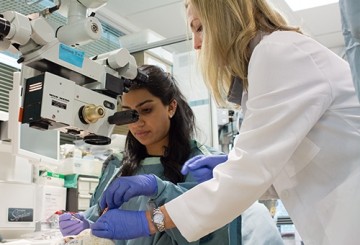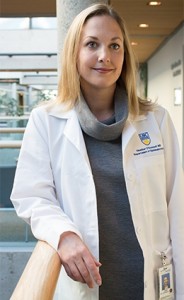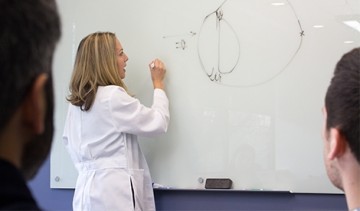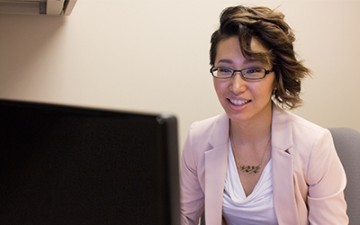UBC unveils a new initiative to support medical residents to become effective teachers.

Heather O’Donnell, a fifth-year ophthalmology resident, supports UBC medical student Rahana Harjee with her first corneal stitch at Vancouver General Hospital’s Eye Care Centre.
Rahana Harjee, a second-year UBC medical student, clasps the micro-needle driver in one hand, while carefully suturing a laceration in a porcine cornea.
It’s Harjee’s first time in the Research Wet Lab of Vancouver General Hospital’s Eye Care Centre. It’s also the first corneal stich of her medical career.
“Great work,” says Heather O’Donnell, a fifth-year ophthalmology resident, observing Harjee’s thoughtful moves.

“You’re going to try and get the tip of needle into the corneal wound and then you’re going to pass it through the wound and come out the other side. And you’re going to do that using just the rotation of your wrist,” she coaches.For Dr. O’Donnell, mentoring medical students, like Harjee, has become an integral part of her residency — almost since day one.

Dr. O’Donnell instructs medical students at VGH’s Eye Care Centre.
“Teaching is a big part of residency,” admits Dr. O’Donnell, reflecting back on earlier days as a junior resident conducting orientation sessions for medical students. Today, now that she’s in her final year of training, Dr. O’Donnell’s teaching responsibilities have only expanded. On any given day, she can be found educating medical students in the operating room, mentoring junior residents in the wet lab, or offering more traditional, didactic instruction at academic and ground rounds. Altogether, Dr. O’Donnell estimates she’s logged close to 200 hours of teaching over the past year alone.
And while teaching is part and parcel of postgraduate medical education, until now, learning ‘how to teach’ hasn’t been part of the formal curriculum for residents.
But that’s about to change because, starting this year, UBC’s Office of Faculty Development and Postgraduate Medical Education have launched a new initiative to support residents to become effective teachers.
The postgraduate-wide program, known as Residents as Teachers, or RaT, will help residency programs implement a new curriculum set to address core teaching competencies over the course of a resident’s training.

Erica Amari, Program Manager with the Office of Faculty Development.
“We recognize that there’s a growing need to support residents to become effective teachers,” says Erica Amari, Program Manager with the Office of Faculty Development, who is overseeing the implementation and management of the new program. “Ultimately, we want residency programs to move away from ad-hoc instruction, and towards a standardized model, where residents are provided with the tools they need to succeed as teachers, and are evaluated on their performance so they can improve their teaching skills over time,” she says.
According to Henry Broekhuyse, Director of UBC’s Orthopaedic Residency Program and faculty lead on the Residents as Teachers initiative, there are a number of important benefits to rolling out a PGME-wide teaching curriculum for residents.
“Firstly, the RaT initiative will offer our residency programs additional expertise and resources to develop and deliver the teaching curriculum,” says Dr. Broekhuyse. “Also, as residents provide a significant amount of clinical teaching to UBC medical students and their junior peers, this program will ensure all of our residents are well prepared, and feel confident serving in their roles as teachers.”
Just over six months after being unveiled, the RaT program is already gaining interest from postgraduate medical education programs, with many residents, like Dr. O’Donnell, hopping on board
“I think the RaT program is a brilliant way to address the existing gap,” says Dr. O’Donnell, who’s looking to work with her fellow residents and program director to weave the new curriculum into the existing five-year Ophthalmology Residency Program. “While residents are given guidelines and support through their individual programs, until now, there hasn’t been a program-wide and formal teaching curriculum.”
The new RaT curriculum — co-developed by the Office of Faculty Development and leaders in the medical education community — comes complete with instruction guides, speaker notes, interactive training materials, and handouts.
“Every residency program will have a unique approach to rolling out the new curriculum, and we encourage programs to tailor the teaching materials to ensure they’re relevant for their learners,” says Amari, noting that the Office of Faculty Development is available to support residency programs every step of the way.
For Roger Wong, Associate Dean of Postgraduate Medical Education, training residents to become effective teachers is high on the list of priorities.
“Teaching is a skill that needs to be taught like any other,” says Dr. Wong, who helped spearhead the initiative with the Office of Faculty Development. “By implementing the new RaT curriculum, we’ll not only be equipping our residents with the skills they need to become effective teachers, but making sure residency programs are meeting accreditation requirements in the years to come.”
Meanwhile, some UBC residency programs, like Surgical Foundations and Emergency Medicine, are ahead of the curve, having already implemented resident teaching programs for their residents.
“Teaching is a large part of what we do as physicians, but we rarely get taught ‘how to teach’,” says Brian Chung, who has served as the Program Director of the Emergency Medicine Residency Program for nearly two decades.
In 2011, recognizing the curricular gap, Dr. Chung launched a four-week rotation, known as Medical Education for Residents in Training (or MERIT), dedicated to training senior Emergency Medicine residents ‘how to teach.’
Today, through a mixture of class-room lectures and direct experience in the Emergency Department, residents are trained how to teach everything from procedure skills to clinical reasoning at the bedside.
In addition to helping the residents, Dr. Chung acknowledges that MERIT has also become an important development opportunity for faculty, many of whom have played an active role designing and teaching the curriculum.
Next year, as programs begin to implement the RaT curriculum, resident support will play an essential role.
Fortunately, as is the case of the Ophthalmology program, residents, like O’Donnell, are not only keen to support the initiative, but looking to help drive the change.
“I am certain that, as I make the jump between fifth-year residency and head into practice, maintaining involvement in training both medical students and residents is going to be an important part of the transition,” says Dr. O’Donnell, who will be wrapping up her residency this summer.
“Whether it’s educating our fellow colleagues through continuing medical education paths, or training medical students and residents who come after us, teaching is part of our responsibility as physicians,” she adds.
Find out more about UBC’s Residents as Teachers initiative and learn about upcoming facilitator workshops by visiting the Office of Faculty Development’s website http://facdev.med.ubc.ca/residents-as-teachers/
Article written by: Kerry Blackadar